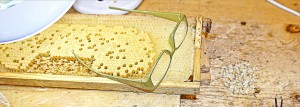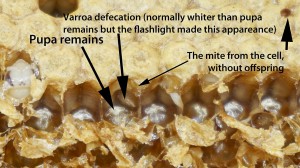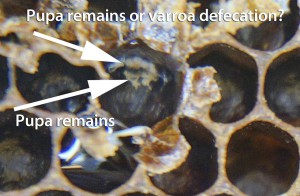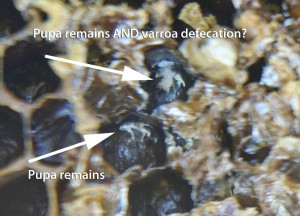I’m checking my, as I think, most promising colonies for the VSH trait. (http://www.elgon.es/diary/?p=146) After dragging out more than 1000 pupae I have learned a lot about analyzing what I see. But I understand it’s more to learn. And I’m becoming faster doing the VSH-test. I have tried a reading lens with a ring lamp + extra 2.5 reading glasses. Together 5 times enlarging. Works great.
All pupae leave some white remains at the bottom of the cell. Mites defecate and leaves more white stuff often little higher up on the cellwall. When there’s a whole varroa family you find quite a lot of white stuff, sometimes covering the bottom.
A mite without offspring leave most often just a little extra white, sometimes almost nothing (can be hard detecting such a mite, but if missed doesn’t result in too good figures). New white wax comb makes it easier to detect mites without offspring.
Now some questions.
- Does an older pupa than a younger one (with just darkened eyes) give more whitish remains at the bottom of the cell? (Just from the pupa and not from a mite?)
- If you find pupa remains AND just above it a small whitish stuff, more compact like varroa defecation, (I know it could be varroa defecation) is that always varroa defecation or could it, in case with an old pupa just about to emerge by itself, be more pupa remains due to the older pupa?
This could be important questions as if it is varroa defecation there is a mite even if I can’t see it. Once I saw a mite popping out from a pupa after it had been laying for a while on the table, a pupa from such a cell. This was seen on a dark comb, where it’s more difficult to detect a single mite without offspring. Often such single mites also are not as movable as one in a cell with a whole varroa family.
Anyone out there that has detected pupae remains in the cells after dragging them out? Have you seen the varroa defecation? Differences between them, and compared to pupae remains? It would be interesting to know.




I have done this test only once and had poor magnification. Was doing that in the field with the sun in my back. I used a chinese model glass, where I had to pull the comb near to my eyes in order to see the mites and pupae sharp. However, this was exhausting. Now I have bought a lenses with 2,5x magnification that allow an easy working with outstretched arms. But haven’t done any test this year.
Sorry can’t help you at this moment. The only thing I heard is that the orientation of the mite faces is different (10’clock or so), plus the colour of the mite faeces is different.
Regards,
Rüdiger